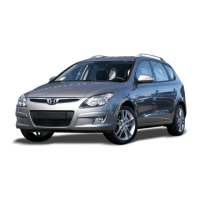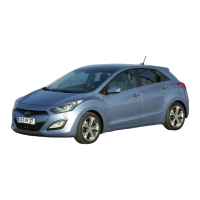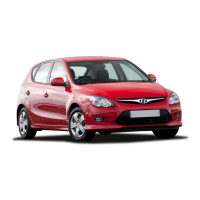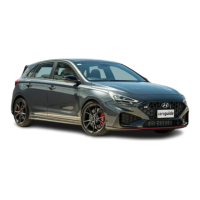Do you have a question about the Hyundai i30 2018 and is the answer not in the manual?
Provides a front view of the vehicle, detailing external components like door locks, sunroof, hood, mirrors, and lamps.
Offers a rear view of the vehicle, illustrating external features such as the fuel filler door, tailgate, antenna, and rear lamps.
Details interior components, including door handles, power window switches, fuse box, steering wheel, and seat adjustments.
Explains the front instrument panel, covering the instrument cluster, light controls, wipers, audio controls, cruise control, and airbags.
Covers the lower part of the instrument panel, detailing power outlets, seat warmers, steering wheel controls, and transmission shift lever.
Identifies key components within the engine compartment, including coolant reservoir, brake fluid reservoir, air cleaner, and battery.
Outlines critical safety measures, including seat belt use, child restraint, air bag hazards, driver distraction, speed control, and vehicle condition.
Describes front and rear seat adjustments, including manual and power adjustments, seat cushion height, lumbar support, and headrests.
Explains seat belt usage, precautions when adjusting, proper positioning, and child restraint system requirements.
Details air bag system operation, precautions for reducing injury from inflating air bags, and what to expect after deployment.
Covers recommendations for child restraint systems, selection criteria, and proper installation in the vehicle.
Illustrates the locations of various air bags (front, side, curtain, knee) and the front passenger air bag ON/OFF switch.
Explains how to use the remote key and smart key for locking, unlocking, and accessing the tailgate.
Details operating door locks from outside and inside the vehicle, including emergency procedures and auto lock/unlock features.
Covers power windows operation, including auto up/down, automatic reverse, and the power window lock switch.
Explains how to operate the sunroof, including sliding, tilting, closing, resetting, and open warnings.
Describes exterior features such as opening the hood, closing the hood, and opening/closing the tailgate.
Details the instrument cluster layout, including gauges, meters, warning lights, and the LCD display.
Explains exterior lighting controls, including headlamp operation, static bending light, and turn signals.
Covers windshield and rear window wiper/washer operation, including AUTO control and service positions.
Introduces driver assistance systems like the rear view camera and rear parking assist system.
Explains automatic heating and air conditioning operation, mode selection, temperature control, and air intake control.
Details features like cluster ionizer, automatic ventilation, and sunroof inside air recirculation.
Covers storage options such as the center console storage and glove box, with safety warnings.
Describes interior features like ashtray, cup holders, sunvisor, and power outlets.
Explains how to connect audio devices using AUX, USB, and iPod® ports for audio playback.
Briefly describes the shark fin antenna's function in receiving transmitted data for radio and GPS.
Details the functions of audio controls on the steering wheel, including volume, seek/preset, mode, and mute buttons.
Explains how to use Bluetooth® for hands-free phone calls, audio streaming, and managing contacts.
Directs users to a separate manual for detailed information on the AVN system, including audio, video, and navigation.
Provides a basic explanation of AM and FM radio signal reception and factors affecting signal quality.
Shows the layout of audio system controls for different types (Type A and Type B) with touch screen functionality.
Details the audio system's head unit features, including LCD screen, radio, seek/track, power/volume knob, and reset function.
Explains how to switch between FM/AM, search stations, view available stations, and manage presets and menus.
Covers supported audio formats, bitrate ranges, number of recognizable folders/files, and character display capabilities.
Provides information on using Bluetooth® for phone calls, including pairing devices, operating during calls, and managing favourites.
Emphasizes pre-driving checks, including windows, mirrors, lights, tires, leaks, obstacles, and ensuring the vehicle is ready to drive.
Explains the key ignition switch positions (LOCK, ACC, ON, START) and associated actions and warnings.
Details the operation of the Engine Start/Stop button, including emergency engine shut-off and restarting procedures.
Covers manual transmission operation, including shifting gears, using the clutch, and downshifting techniques.
Explains the Rev Matching system's automatic synchronization of engine RPM for smoother gear shifts.
Describes the procedure for activating Launch Control for reduced wheel spin during hard acceleration from a standstill.
Details power brakes, disc brake wear indicators, high-performance brakes, parking brake operation, ABS, ESC, and VSM.
Explains the Electronic Limited Slip Differential (e-LSD) feature and its drive mode selection.
Covers the Drive Mode system, including ECO, SPORT, and N modes, and their impact on vehicle dynamics.
Explains the ISG system for reducing fuel consumption by automatically shutting down the engine when the vehicle is at a standstill.
Details the AEB system's function, system setting and activation, and precautions for its use.
Explains how the SLIF displays speed limit information and overtaking restrictions detected via camera and navigation.
Describes the LKAS system's function to detect lane markers and assist the driver with steering.
Explains the LDWS function, which alerts the driver with visual and audible warnings when the vehicle departs from its lane.
Covers the DAA system's display of driver fatigue levels and inattentive driving practices, including system modes and resetting.
Details Cruise Control operation, including setting speed, increasing/decreasing speed, and temporary acceleration.
Provides precautions for hazardous driving conditions like snow, ice, mud, sand, and hazardous road surfaces.
Offers advice for minimizing winter driving problems, including snow/icy conditions, snow tires, and tire chains.
Covers legal requirements for towing, trailer weight, tongue load, hitches, safety chains, and trailer brakes.
Explains vehicle weight ratings like Base Curb Weight, Vehicle Curb Weight, Cargo Weight, GAW, GAWR, GVW, and GVWR.
Explains the function and operation of the hazard warning flasher as a warning signal to other drivers.
Provides immediate actions if the engine stalls while driving or at a crossroads.
Covers troubleshooting steps when the engine doesn't turn over or turns over slowly.
Details the procedure and safety precautions for jump starting a vehicle to avoid injury or damage.
Guides on what to do if the engine overheats, including stopping safely and checking for coolant leaks.
Explains the TPMS function, including checking tire pressure, malfunction indicators, and low pressure warnings.
Provides instructions on how to change a tire when equipped with TPMS, including safety precautions.
Details the use of the jack and tools, and the process for changing a tire with a spare.
Explains the use of the Tire Mobility Kit for temporary tire repair and inflation, including safety warnings.
Provides instructions and precautions for using the Tire Mobility Kit, emphasizing its temporary nature and limitations.
Discusses towing procedures, equipment, safety precautions, and recommended towing methods.
Outlines procedures and precautions for emergency towing using cables or chains if a service is unavailable.
Lists emergency equipment provided, such as first aid kit, fire extinguisher, triangle reflector, and tire pressure gauge.
Identifies engine compartment components, including coolant reservoir, brake fluid reservoir, air cleaner, oil dipstick, and battery.
Stresses the importance of owner maintenance and recommends authorized HYUNDAI dealer services for repairs.
Provides a schedule for owner-performed checks and inspections, including engine oil, coolant, and tire pressure.
Differentiates between Normal Maintenance Schedule and Maintenance Under Severe Usage Conditions based on driving environments.
Explains specific maintenance items like engine oil, drive belts, fuel filter, and spark plugs.
Covers tire care, recommended pressures, rotation, alignment, replacement, traction, sidewall labeling, and wheel information.
Describes the types of fuses used, how to replace a blown fuse, and warnings about incorrect fuse usage.
Provides step-by-step instructions for replacing fuses in the instrument panel fuse panel.
Explains the function of the fuse switch and the importance of keeping it in the ON position.
Details the fuses and relays located in the engine compartment fuse panel.
Explains how to find the fuse/relay label inside the fuse/relay box covers for identification.
Guides on replacing various vehicle light bulbs, including headlamps, turn signals, and interior lights.
Provides advice on exterior and interior care, including washing, waxing, and cleaning different surfaces.
Explains the vehicle's emission control systems: crankcase, evaporative, and exhaust, and recommends professional inspection.
Lists the vehicle's overall dimensions, including length, width, height, and wheel tread.
Provides engine specifications such as displacement, bore x stroke, firing order, and number of cylinders.
Details the wattage and type of bulbs used for various exterior and interior lighting components.
Covers tire size, wheel size, inflation pressures, lug nut torque, and tire composition.
Lists tire load index and speed capacity ratings for vehicles sold in Europe.
Provides specifications for the air conditioning system, including refrigerant type and compressor lubricant.
Details vehicle weight ratings and luggage capacity in liters and cubic feet.
Recommends specific lubricants and fluids for the engine, transmission, coolant, and brake systems.
Provides a chart for selecting engine oil viscosity based on ambient temperature for optimal performance.
Explains where to find the vehicle identification number (VIN) on the frame, dashboard, and certification label.
Identifies the vehicle certification label location and the information it contains, including the VIN.
Locates the tire label and explains how to find recommended tire pressures and specifications.
Shows where the engine number is stamped on the engine block.
Explains the information found on the air conditioner compressor label, including model and refrigerant details.
Provides information on the refrigerant label, including type and amount, located under the hood.
States that the vehicle's radio frequency components comply with EU Directive 1995/5/EC.
Provides a front view of the vehicle, detailing external components like door locks, sunroof, hood, mirrors, and lamps.
Offers a rear view of the vehicle, illustrating external features such as the fuel filler door, tailgate, antenna, and rear lamps.
Details interior components, including door handles, power window switches, fuse box, steering wheel, and seat adjustments.
Explains the front instrument panel, covering the instrument cluster, light controls, wipers, audio controls, cruise control, and airbags.
Covers the lower part of the instrument panel, detailing power outlets, seat warmers, steering wheel controls, and transmission shift lever.
Identifies key components within the engine compartment, including coolant reservoir, brake fluid reservoir, air cleaner, and battery.
Outlines critical safety measures, including seat belt use, child restraint, air bag hazards, driver distraction, speed control, and vehicle condition.
Describes front and rear seat adjustments, including manual and power adjustments, seat cushion height, lumbar support, and headrests.
Explains seat belt usage, precautions when adjusting, proper positioning, and child restraint system requirements.
Details air bag system operation, precautions for reducing injury from inflating air bags, and what to expect after deployment.
Covers recommendations for child restraint systems, selection criteria, and proper installation in the vehicle.
Illustrates the locations of various air bags (front, side, curtain, knee) and the front passenger air bag ON/OFF switch.
Explains how to use the remote key and smart key for locking, unlocking, and accessing the tailgate.
Details operating door locks from outside and inside the vehicle, including emergency procedures and auto lock/unlock features.
Covers power windows operation, including auto up/down, automatic reverse, and the power window lock switch.
Explains how to operate the sunroof, including sliding, tilting, closing, resetting, and open warnings.
Describes exterior features such as opening the hood, closing the hood, and opening/closing the tailgate.
Details the instrument cluster layout, including gauges, meters, warning lights, and the LCD display.
Explains exterior lighting controls, including headlamp operation, static bending light, and turn signals.
Covers windshield and rear window wiper/washer operation, including AUTO control and service positions.
Introduces driver assistance systems like the rear view camera and rear parking assist system.
Explains automatic heating and air conditioning operation, mode selection, temperature control, and air intake control.
Details features like cluster ionizer, automatic ventilation, and sunroof inside air recirculation.
Covers storage options such as the center console storage and glove box, with safety warnings.
Describes interior features like ashtray, cup holders, sunvisor, and power outlets.
Explains how to connect audio devices using AUX, USB, and iPod® ports for audio playback.
Briefly describes the shark fin antenna's function in receiving transmitted data for radio and GPS.
Details the functions of audio controls on the steering wheel, including volume, seek/preset, mode, and mute buttons.
Explains how to use Bluetooth® for hands-free phone calls, audio streaming, and managing contacts.
Directs users to a separate manual for detailed information on the AVN system, including audio, video, and navigation.
Provides a basic explanation of AM and FM radio signal reception and factors affecting signal quality.
Shows the layout of audio system controls for different types (Type A and Type B) with touch screen functionality.
Details the audio system's head unit features, including LCD screen, radio, seek/track, power/volume knob, and reset function.
Explains how to switch between FM/AM, search stations, view available stations, and manage presets and menus.
Covers supported audio formats, bitrate ranges, number of recognizable folders/files, and character display capabilities.
Provides information on using Bluetooth® for phone calls, including pairing devices, operating during calls, and managing favourites.
Emphasizes pre-driving checks, including windows, mirrors, lights, tires, leaks, obstacles, and ensuring the vehicle is ready to drive.
Explains the key ignition switch positions (LOCK, ACC, ON, START) and associated actions and warnings.
Details the operation of the Engine Start/Stop button, including emergency engine shut-off and restarting procedures.
Covers manual transmission operation, including shifting gears, using the clutch, and downshifting techniques.
Explains the Rev Matching system's automatic synchronization of engine RPM for smoother gear shifts.
Describes the procedure for activating Launch Control for reduced wheel spin during hard acceleration from a standstill.
Details power brakes, disc brake wear indicators, high-performance brakes, parking brake operation, ABS, ESC, and VSM.
Explains the Electronic Limited Slip Differential (e-LSD) feature and its drive mode selection.
Covers the Drive Mode system, including ECO, SPORT, and N modes, and their impact on vehicle dynamics.
Explains the ISG system for reducing fuel consumption by automatically shutting down the engine when the vehicle is at a standstill.
Details the AEB system's function, system setting and activation, and precautions for its use.
Explains how the SLIF displays speed limit information and overtaking restrictions detected via camera and navigation.
Describes the LKAS system's function to detect lane markers and assist the driver with steering.
Explains the LDWS function, which alerts the driver with visual and audible warnings when the vehicle departs from its lane.
Covers the DAA system's display of driver fatigue levels and inattentive driving practices, including system modes and resetting.
Details Cruise Control operation, including setting speed, increasing/decreasing speed, and temporary acceleration.
Provides precautions for hazardous driving conditions like snow, ice, mud, sand, and hazardous road surfaces.
Offers advice for minimizing winter driving problems, including snow/icy conditions, snow tires, and tire chains.
Covers legal requirements for towing, trailer weight, tongue load, hitches, safety chains, and trailer brakes.
Explains vehicle weight ratings like Base Curb Weight, Vehicle Curb Weight, Cargo Weight, GAW, GAWR, GVW, and GVWR.
Explains the function and operation of the hazard warning flasher as a warning signal to other drivers.
Provides immediate actions if the engine stalls while driving or at a crossroads.
Covers troubleshooting steps when the engine doesn't turn over or turns over slowly.
Details the procedure and safety precautions for jump starting a vehicle to avoid injury or damage.
Guides on what to do if the engine overheats, including stopping safely and checking for coolant leaks.
Explains the TPMS function, including checking tire pressure, malfunction indicators, and low pressure warnings.
Provides instructions on how to change a tire when equipped with TPMS, including safety precautions.
Details the use of the jack and tools, and the process for changing a tire with a spare.
Explains the use of the Tire Mobility Kit for temporary tire repair and inflation, including safety warnings.
Provides instructions and precautions for using the Tire Mobility Kit, emphasizing its temporary nature and limitations.
Discusses towing procedures, equipment, safety precautions, and recommended towing methods.
Outlines procedures and precautions for emergency towing using cables or chains if a service is unavailable.
Lists emergency equipment provided, such as first aid kit, fire extinguisher, triangle reflector, and tire pressure gauge.
Identifies engine compartment components, including coolant reservoir, brake fluid reservoir, air cleaner, oil dipstick, and battery.
Stresses the importance of owner maintenance and recommends authorized HYUNDAI dealer services for repairs.
Provides a schedule for owner-performed checks and inspections, including engine oil, coolant, and tire pressure.
Differentiates between Normal Maintenance Schedule and Maintenance Under Severe Usage Conditions based on driving environments.
Explains specific maintenance items like engine oil, drive belts, fuel filter, and spark plugs.
Covers tire care, recommended pressures, rotation, alignment, replacement, traction, sidewall labeling, and wheel information.
Describes the types of fuses used, how to replace a blown fuse, and warnings about incorrect fuse usage.
Provides step-by-step instructions for replacing fuses in the instrument panel fuse panel.
Explains the function of the fuse switch and the importance of keeping it in the ON position.
Details the fuses and relays located in the engine compartment fuse panel.
Explains how to find the fuse/relay label inside the fuse/relay box covers for identification.
Guides on replacing various vehicle light bulbs, including headlamps, turn signals, and interior lights.
Provides advice on exterior and interior care, including washing, waxing, and cleaning different surfaces.
Explains the vehicle's emission control systems: crankcase, evaporative, and exhaust, and recommends professional inspection.
Lists the vehicle's overall dimensions, including length, width, height, and wheel tread.
Provides engine specifications such as displacement, bore x stroke, firing order, and number of cylinders.
Details the wattage and type of bulbs used for various exterior and interior lighting components.
Covers tire size, wheel size, inflation pressures, lug nut torque, and tire composition.
Lists tire load index and speed capacity ratings for vehicles sold in Europe.
Provides specifications for the air conditioning system, including refrigerant type and compressor lubricant.
Details vehicle weight ratings and luggage capacity in liters and cubic feet.
Recommends specific lubricants and fluids for the engine, transmission, coolant, and brake systems.
Provides a chart for selecting engine oil viscosity based on ambient temperature for optimal performance.
Explains where to find the vehicle identification number (VIN) on the frame, dashboard, and certification label.
Identifies the vehicle certification label location and the information it contains, including the VIN.
Locates the tire label and explains how to find recommended tire pressures and specifications.
Shows where the engine number is stamped on the engine block.
Explains the information found on the air conditioner compressor label, including model and refrigerant details.
Provides information on the refrigerant label, including type and amount, located under the hood.
States that the vehicle's radio frequency components comply with EU Directive 1995/5/EC.
| Brand | Hyundai |
|---|---|
| Model | i30 2018 |
| Category | Automobile |
| Language | English |












